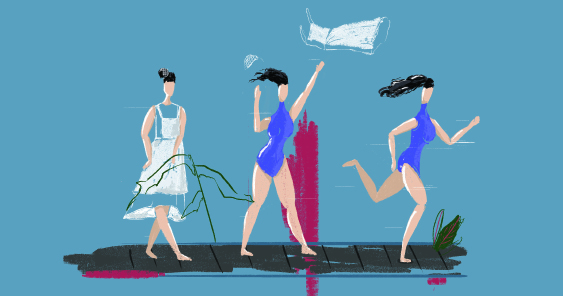Words by Adrienne Dy
Illustration by Edward Joson
Rush hour traffic gives you front row seats to billboard boulevard. Snow white, svelte women for whitening products and slimming centers. Men oozing with machismo, for gyms, cars and health supplements. Smiling mothers in aprons, whipping up sumptuous merienda for their kids. Little boys in capes, little girls in skirts. By the time you get to your destination, you’ve already consumed an unhealthy serving of clichés and stereotypes – and you didn’t even know it.
It’s a known fact that ads sell ideas, not products. It’s those lingering images and subliminal messages that stick to the brain, and creep into our life views and behavior. It’s why the ad industry thrives – and why it should be all the more conscientious. Especially when it comes to gender stereotypes.
Typecasting
While sex (biological) and sexuality (psychological) are mostly unchangeable attributes, gender is subject to interpretation, making it the easiest to manipulate. Alvesson and Billing (1997) define gender as “the social and cultural meanings associated with maleness and femaleness imposed and expected by society.”
It’s the reason men are depicted as masculine, strong, aggressive, dominant, rational and active, while women are shown as feminine, weak, submissive, emotional and passive, explains Bulgarian Professor Dr. Diana Popova. “On the one hand, advertising plays a significant role in the development and perpetuation of gender-role stereotypes. On the other, it is a reflection of the realities at a particular point in time,” she writes.
Following her logic, the TV and billboards are practically mirrors of today’s society. Machismo and sexism are everyday realities – just look at recently elected leaders or today’s paper. But alongside it, a new breed of advertising is also thriving.
Femvertising
While subtle gender stereotyping can go unquestioned, the more blatant ones get serious flak. Kevin Roberts’ public flogging just last year is a prime cautionary tale. The former executive of Saatchi & Saatchi lost both his reputation and job by declaring the debate on gender diversity in the ad industry “over.” On the front end, ads that seek to break stereotypes are edging out more “traditional” ones.
Enter femvertising, the industry’s lash against its own gender portrayals. Ads that dispel negative stereotypes against women have more than salvaged the industry, winning over growing numbers of feminist-leaning consumers.
It was a stroke of genius by—ironically—beauty and cosmetics brands. Dove’s ‘Real Beauty’ campaign started it all in 2004. Locally, it was Pantene’s award-winning ‘Labels Against Women’ in 2013.
Since 2014, femverts have been striking gold: ‘#thisgirlcan’ campaign from Sport England, ‘#LikeAGirlcampaign’ from Always, ‘#Stresstest’ advert from Secret Deodorant. These days, active wear labels Nike and Under Armour are getting more brazen with advertising, sometimes attacking both gender and cultural stereotypes with campaigns like ‘This is Us,’ ‘What are girls made of?,’ ‘I Will What I Want,’ and ‘Rule Yourself.’
Awards are now designed around it, like the annual #Femvertising Awards of SheKnows Media, entering its third year now. In its survey on pro-female ads, the digital media company found out that 97% of women think that ads impact how society views them, and 82% want to see real women in ads.
Samantha Skey, president of SheKnows Media, said, “We’ve expanded our contemplation of #Femvertising to look at how all genders are represented and where the stereotypes and the negative representation exists.” On the other side of the spectrum, manvertising is also gaining ground. In a 180-degree turn, Axe has abandoned its infamously macho image for a more “realistic depiction” of men in its ‘Find Your Magic’ campaign. And yes, there’s now such a thing as dadvertising.
This article was published in the adobo magazine Gender 2017 issue.









